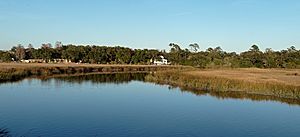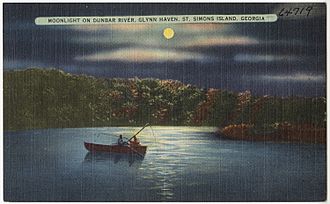Igbo Landing facts for kids
Quick facts for kids Igbo Landing |
|
|---|---|

The area of Igbo Landing
|
|
| Location | Dunbar Creek, St. Simons Island in Glynn County, Georgia, United States |
| Lua error in Module:Location_map at line 420: attempt to index field 'wikibase' (a nil value). | |

A 1930 post card showing moonlight on Dunbar River, Glynn Haven, St. Simons Island, Georgia
|
|
| Date | May 1803 |
|---|---|
| Participants | A group of 75 Igbo enslaved people |
| Outcome | Notable influence on African American folklore and literature |
| Deaths | 13 |
Igbo Landing is a special place in history located at Dunbar Creek on St. Simons Island, Glynn County, Georgia. In 1803, a group of Igbo people who had been captured and forced onto a slave ship chose to resist slavery in a powerful way. They took control of their ship and, instead of becoming enslaved, walked into the water. This event is a strong symbol of resistance against slavery. It has become an important part of African American stories and literature, especially in the legend of the flying Africans.
Contents
A Brave Act of Resistance
In May 1803, a ship full of people from West Africa arrived in Savannah. These people had survived the terrible journey across the ocean, known as the Middle Passage. They were going to be sold into slavery. Among them were many Igbo people from what is now Nigeria. The Igbo were known for being very independent and for resisting being enslaved.
The Journey to St. Simons Island
A group of 75 enslaved Igbo people were bought by agents for plantations on St. Simons Island. They were chained and put on a small ship called The Schooner York (some say The Morovia). This ship was supposed to take them to the island.
The Rebellion and Choice
During this short journey, the Igbo people bravely rebelled. They took control of the ship. In the process, the ship ran aground in Dunbar Creek, at the place now known as Igbo Landing.
What happened next is a powerful story. It is said that the Africans went ashore. Then, led by an Igbo chief, they walked together into the creek. They sang in their Igbo language, "The Water Spirit brought us, the Water Spirit will take us home." They chose death over a life of slavery, seeking protection from their god Chukwu.
One of the few written accounts from that time was by Roswell King, a white overseer. He wrote that the Igbo people went into the swamp as soon as they landed and died by walking into Dunbar Creek. Another account says that 10 to 12 people drowned, while some were "saved" by people who hunted for bounties.
Why This Event Matters
Igbo Landing marks a "major act of resistance" by Africans in 1803. This event has had a lasting impact on African-American folklore and literature. Some people even call the Igbo mutiny the first "freedom march" in American history.
For a long time, many thought these stories were just folktales. However, research since the 1980s has shown that the legend is based on real historical events. The site was recognized as a historic place in 2009.
Today, Igbo Landing does not have an official historical marker. Even so, historians and tourists still visit the site. The story of Igbo Landing is now taught in schools along the coast of Georgia.
Stories Passed Down
The story of the Igbo people who chose death over slavery is a very important part of African American and Gullah oral history. Like many stories passed down by word of mouth, some details have changed over time.
The Water-Walking Myth
Floyd White, an elderly African American, shared his version of the story in the 1930s:
Heard about the Ibo's Landing? That's the place where they bring the Ibos over in a slave ship and when they get here, they ain't like it and so they all start singing and they march right down in the river to march back to Africa, but they ain't able to get there. They gets drown.
A common Gullah version of the story, shared by Linda S. Watts, tells how the West Africans decided to risk their lives by walking home over the water. They did not want to live as slaves. The story says they got off the ship and walked into the water, singing a hymn about water spirits taking them home. All versions of this story show the great courage of the enslaved Igbo people.
The Flying Africans Myth
Another popular legend connected to Igbo Landing is about the flying Africans. This story was also collected in the 1930s. In these tales, the Africans are said to have grown wings or turned into vultures. Then, they flew back home to freedom in Africa.
Wallace Quarterman, born in 1844, was asked about Igbo Landing in 1930. He said:
Ain't you heard about them? Well, at that time Mr. Blue he was the overseer and ... Mr. Blue he go down one morning with a long whip for to whip them good. ... Anyway, he whipped them good and they got together and stuck that hoe in the field and then ... rose up in the sky and turned themselves into buzzards and flew right back to Africa. ... Everybody knows about them.
Professor Terri L. Snyder believes the flying African folktale likely comes from the 1803 event at Igbo Landing. She notes that the Igbo captives revolted, and then "took to the marsh" and drowned. This event led to the unique local stories and the name Ebos Landing.
However, Professor Jeroen Dewulf has a different idea. He points out that while there are many stories about Igbos and enslaved Africans flying home, the idea that these two myths are directly linked might not be strong. He thinks the flying Africans myth might have come from other parts of Africa, like the Kingdom of Loango and the Kingdom of Kongo.
Reported Haunting
Some local people believe that Igbo Landing and the nearby marshes in Dunbar Creek are haunted by the spirits of the Igbo people who died there.
Lasting Impact
In September 2002, the St. Simons African-American Heritage Coalition held a special two-day event. It honored Igbo history and included a procession to the site. People from other states, Nigeria, Belize, and Haiti attended. They came to declare the site as holy ground and to bring peace to the souls of the dead. The story of the Igbo people is now part of the history lessons in coastal Georgia schools.
In Books and Movies
The historical events of the Igbo slave escape and the myths connected to it have inspired many artists.
- Nobel winner Toni Morrison used the flying Africans myth in her novel, Song of Solomon.
- Alex Haley retells the story in his famous book Roots.
- The novel Praisesong for the Widow by Paule Marshall was also inspired by these events.
- The film Daughters of the Dust (1993), directed by Julie Dash, tells the story from the perspective of Gullah descendants.
- The 1994 film Welcome II the Terrordome by Ngozi Onwurah includes a dramatic scene of the Igbo landing.
- Other artists like Joseph Zobel, Maryse Conde, Toni Cade Bambara, and Jamaica Kincaid also refer to the flying Africans tale in their work.
- Some parts of Beyoncé's visual album Lemonade are said to be inspired by Daughters of the Dust and the Igbo Landing story.
- In the 2018 Marvel film Black Panther, the character Killmonger mentions Igbo Landing in his final scene. He says, “Bury me in the ocean with my ancestors who jumped from ships, 'cause they knew death was better than bondage.”

